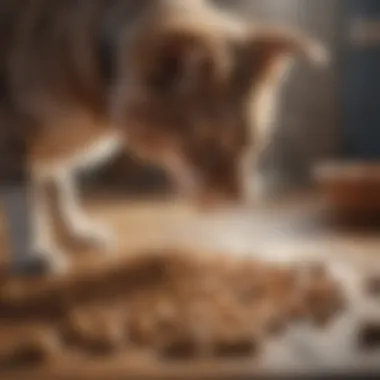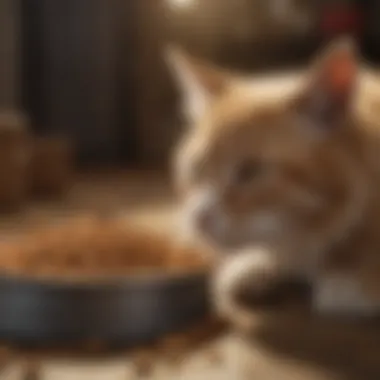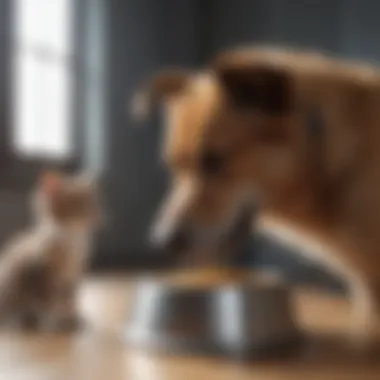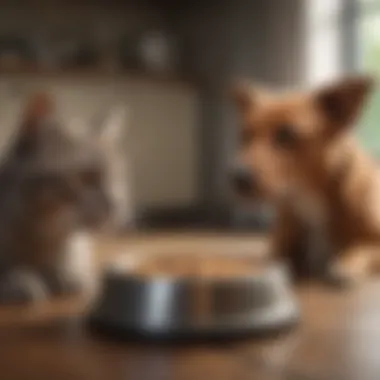Understanding Why Dogs Are Attracted to Cat Food


Intro
The phenomenon of dogs eating cat food can be perplexing for pet owners. Understanding the reasons behind this behavior requires an exploration of the motivations that drive dogs. It also involves investigating the nutritional differences between dog food and cat food. In multi-pet households, this behavior can be common, leading to potential health concerns for dogs. This article aims to dissect these issues, providing insight into the behavioral patterns, nutritional ramifications, and strategies to manage feeding habits effectively.
Fascinating Facts About the Animal
Unique Characteristics
Dogs and cats have distinct dietary needs shaped by their evolutionary backgrounds. Dogs are omnivores, while cats are obligate carnivores. This difference means that cat food often contains higher levels of proteins and fats that dogs may find appealing. Additionally, the texture and smell of cat food can stimulate a dog's curiosity.
Extraordinary Abilities
Dogs possess an incredible sense of smell, which influences their behavior significantly. They can detect scents at much lower concentrations than humans. This ability helps them explore their surroundings deeply, making them more likely to seek out cat food if they sense it nearby.
Behavior and Habitat
Natural Habitats
In natural settings, both dogs and cats exhibit unique feeding behaviors. Dogs are opportunistic eaters, taking what is available in their environment. This instinct may contribute to their interest in cat food, especially if it is easily accessible.
Social Structures
The social dynamics in a mixed pet household can also affect feeding habits. Dogs often observe and mimic the eating behaviors of cats. When dogs see cats eating, their curiosity may prompt them to sample cat food, driven by a blend of instinct and social learning.
Recent Scientific Discoveries
Latest Research Findings
Recent studies have examined the nutritional preferences of dogs. These studies show that dogs may prefer higher protein and fat foods, often found in cat food. The balance of nutrients can influence their desire to eat cat food over their own.
Breakthroughs in Animal Biology
Research in animal biology reveals that digestive systems of dogs adapt to various diets. Dogs may digest cat food adequately, yet regular consumption can lead to health issues. It's essential to understand the biological implications of this behavior for better pet care.
Cultural Significance
Animals in Folklore
Across cultures, dogs and cats have held significant symbolic meanings. Their relationships have been depicted in folklore, influencing our perception of their behaviors. Understanding this cultural context can provide insights into why certain behaviors, like eating from each other's food bowls, may occur.
Influence on Art and Literature
The interactions between dogs and cats have been a common theme in art and literature. These narratives often reflect the quirks of these two animals, highlighting their differences and similarities. This cultural backdrop underscores the relevance of studying behaviors like feeding preferences.
"Dogs and cats share a unique relationship, often reflecting our own dynamics as humans. Their behaviors provide fascinating insights into their shared experiences and needs."
Introducing the Issue
The phenomenon of dogs eating cat food is a common issue that many pet owners encounter in mixed-pet households. Understanding the reasons behind this behavior is crucial for ensuring the health and well-being of both dogs and cats. There are several elements to consider that illuminate this topic.
One key aspect is the dietary preferences of canines. Dogs and cats have different nutritional requirements, yet dogs often seem drawn to cat food. This can stem from curiosity, their natural instincts, or even their diet. Recognizing these underlying factors helps pet owners provide a more suitable feeding strategy.
Moreover, this behavior might lead to unforeseen health risks for dogs. If dogs regularly consume cat food, the nutritional imbalance can affect their health.
In discussing this topic, we explore various considerations, such as how being aware of these tendencies can assist in shaping effective feeding practices. Implementing preventative measures and understanding what drives dogs to eat cat food fosters a healthier environment for both pets.


Common Observations
Pet owners often report that their dogs enjoy sneaking cat food whenever they get a chance. Observations show that this behavior arises in various situations. For example, when dogs are fed alongside cats, they might gravitate toward the food of their feline counterparts. This is not merely a chance encounter but rather a manifestation of their instincts.
A few common scenarios include:
- Dogs sneaking into the location where cat food is kept.
- Dogs hanging around the area when the cat is eating.
- Dogs showing heightened excitement when presented with cat food.
These patterns indicate that dogs are not just randomly deciding to eat cat food. Instead, it showcases a degree of interest and desire that pet owners should understand.
Why This Behavior Is Not Unusual
Dogs are inherently curious creatures. They often explore their environment through taste and smell. Encountering cat food can be an exciting experience for them. This behavior aligns with their natural instincts to investigate anything that seems different from their usual diet.
Additionally, many dog owners do not realize that dogs may not perceive the distinction between their food and cat food. Both types of food may be situated in similar spaces, making the transition effortless.
Another point to consider is the possible appeal of cat food's unique scent. Cat food often contains higher levels of proteins and fats when compared to standard dog food. This can render it more enticing to dogs, who may be drawn to the more robust aroma. Recognizing that such behavior is not uncommon allows pet owners to adjust their approaches when raising both dogs and cats together.
Understanding Canine Behavior
Understanding canine behavior is essential to comprehend why dogs sometimes eat cat food. This knowledge connects to broader topics such as animal feeding habits, dietary needs, and welfare in mixed households. Moreover, recognizing these behaviors can help pet owners make informed choices that promote health and well-being for both dogs and cats.
In mixed pet environments, it is common for dogs and cats to exhibit differing food preferences. Hence, understanding canine behavior provides insights into the motivations behind these preferences. By analyzing what drives dogs’ interest in cat food, we can identify potential solutions to manage this behavior, ensuring a harmonious living situation for all pets involved.
Natural Instincts
Dogs have innate instincts rooted in their ancestry. Canines are primarily scavengers, and their ancestors used food sources available in their environment. This behavior persists today. When dogs see or smell cat food, their instincts trigger curiosity and a desire to explore that food source. The high protein content often found in cat food can also attract dogs. The dog may instinctively realize that this source of nutrition has something beneficial.
Additionally, canine instincts are not solely about food. Dogs also have a social nature that compels them to investigate what others, including cats, consume. This social interaction is part of their survival mechanism. Therefore, the inclination to eat cat food may be less about dietary preferences and more about behavioral instincts deriving from pack mentality.
Curiosity and Exploration
Another significant factor in why dogs eat cat food is their curiosity. Dogs are naturally curious creatures. They investigate their surroundings and are always looking for new experiences. When a dog observes a cat eating, it may wish to join in or explore that food. This behavior is more pronounced in dogs that tend to be energetic or younger.
Dogs approach the situation with an exploratory mindset. They may sniff the cat food or try to taste it out of curiosity to understand what it is all about. This exploration is typical for many breeds but may vary individually. Owners observing this curiosity may find it both amusing and troublesome, especially if they wish to maintain specific feeding routines for their pets.
Hunger and Diet Preferences
Hunger is another crucial reason dogs might eat cat food. If dogs feel hungry, they could seek alternative sources of food, especially in households where they share space with cats. Some dog owners might overlook the amount of food given to their pets. If a dog is still hungry after finishing its food, it may turn to cat food out of necessity.
Additionally, dogs may develop a taste for cat food, leading to preferences that go against their dietary requirements. Dogs generally have different nutritional needs than cats due to their evolutionary backgrounds. While cat food may appeal to dogs, relying on it can cause nutritional imbalances.
Dogs like a variety of flavors and textures. Cat food often contains higher fat content compared to many dog foods, which makes it appealing. However, this preference can lead to behaviors that are more problematic in the long term. Keeping this aspect in mind can help pet owners adjust feeding methods and prevent their dogs from seeking out cat food altogether.
Nutritional Differences Between Cat and Dog Food
Understanding the nutritional differences between cat and dog food is essential for pet owners who share their homes with both species. This topic reveals insights into why dogs might be inclined to sample cat food. Both types of food are specially formulated to meet the dietary needs of their respective animals. Recognizing these differences can help prevent potential health problems and ensure pets receive the correct nutrients for their wellbeing.
Protein Content
One of the most significant distinctions between cat and dog food is the protein content. Cats are obligate carnivores, meaning their diet primarily relies on meat. Their food typically contains higher levels of protein compared to dog food, which is designed for omnivorous dogs. For instance, cat food can contain protein levels exceeding 35%, while dog food often ranges between 18% to 25%.
This substantial protein difference not only caters to their specific energy requirements but can also tempt dogs to seek out cat food. Dogs, even if they are not obligate carnivores, still benefit from a protein-inclusive diet, so the rich aroma and taste of cat food may draw their attention. However, too much protein from cat food can strain a dog's kidneys over time, resulting in possible long-term health complications.
Essential Nutrients for Cats and Dogs
The nutrient profiles of cat and dog food vary significantly, showcasing differing requirements. Cats need taurine, an amino acid critical for heart and eye function, along with arachidonic acid, which dogs can synthesize on their own. Additionally, cats require vitamin A in its preformed state, while dogs can convert beta-carotene into vitamin A. Here are some nutrient considerations:


- Cats:
- Dogs:
- Higher vitamin A requirements.
- Essential fatty acids such as arachidonic acid.
- Increased levels of niacin, crucial for their metabolism and energy production.
- Can derive certain vitamins and acids from plant sources.
- Require balanced levels of protein as part of their more diverse diet.
- Adaptable nutrient needs depending on age and activity levels.
These differences highlight why feeding dogs cat food on a regular basis can lead to nutritional imbalances, causing deficiencies or excesses of specific nutrients.
Consequences of Imbalanced Diet
Feeding dogs cat food occasionally may not pose immediate risks, but regular consumption can lead to serious health concerns over time. This behavior can cause:
- Nutritional Excess:
- Nutritional Deficiencies:
- Long-term Health Risks:
- Due to high protein levels, dogs may develop issues such as kidney strain or liver problems. Excessive intake of certain vitamins can also result in toxicity.
- Dogs might miss out on essential components that are critical to their health because of the inadequacies of cat food. Nutrients that cater to a dog's requirements, such as complex carbohydrates, are often absent or insufficient in cat food.
- Obesity is another concern. Dogs consuming high-calorie cat food may gain weight more easily, leading to diabetes and joint problems.
Understanding these points is crucial for pet owners. It’s essential to provide balanced diets tailored to each species to sustain their health and vitality in a mixed-pet household. A quality dog food formulated to meet their unique nutritional requirements is the better option.
Health Risks for Dogs Eating Cat Food
Understanding health risks associated with dogs eating cat food is essential for pet owners. While this behavior may seem harmless at a glance, it can lead to significant health complications for dogs over time. The nutritional composition of cat food is designed specifically for feline diets, which differ markedly from canine requirements. This discrepancy may create several health challenges if a dog regularly consumes cat food.
Potential Digestive Issues
One of the primary concerns with dogs eating cat food is the potential for digestive issues. Dogs' digestive systems are optimized for a different set of nutrients than what cat food provides. The high fat and protein content in cat food can overwhelm a dog’s digestive capabilities, leading to problems such as:
- Diarrhea: Increased fat and protein may disrupt a dog's gut flora, resulting in diarrhea.
- Vomiting: Dogs may also experience vomiting as their bodies attempt to reject the inappropriate food.
- Pancreatitis: In severe cases, the high-fat content can trigger pancreatitis, a painful and serious condition that requires immediate veterinary attention.
Monitoring your dog's reaction to cat food is crucial. If digestive upset occurs, it’s best to separate feeding areas to prevent future issues.
Nutritional Excess and Deficiencies
Feeding dogs cat food can lead to both nutritional excesses and deficiencies, given the differences in dietary requirements between the two species. Cat food often contains higher levels of certain nutrients, which can be detrimental to dogs. On the flip side, it may lack essential nutrients that dogs need. Key points to understand include:
- Excess protein: While dogs can benefit from protein, too much can lead to kidney issues, particularly in older dogs.
- Taurine: Cats require taurine, an amino acid, in their diet. Dogs do not have this same requirement. However, excessive taurine can result in imbalances that affect a dog’s health.
- Lower fiber: Cat food generally contains less fiber than dog food, potentially leading to constipation in dogs who consume it regularly.
The imbalance caused by consuming cat food can lead to long-term health issues if not addressed.
Weight Gain and Obesity Risks
Another significant concern is the risk of weight gain and, ultimately, obesity. Dog owners may not realize that cat food is generally higher in calories compared to dog food. This difference can lead to:
- Increased caloric intake: If a dog consumes cat food in addition to its regular diet, it can lead to unwanted weight gain.
- Health complications: Obesity in dogs is linked to various health problems, including joint issues, diabetes, and heart diseases.
- Decreased activity: Gaining weight can affect a dog's energy levels, making it less active and further exacerbating obesity issues.
It is important to monitor your dog's weight and adjust their diet appropriately to prevent obesity.
To sum up, while the occasional indulgence in cat food may not pose immediate risks, regular consumption carries significant potential health threats. Awareness and proactive management can protect dogs from these health complications.
Managing Pets in a Mixed Household
Managing pets in a mixed household is a crucial aspect when considering the dynamics between different animal species. When dogs and cats share a living space, their feeding behaviors can significantly overlap, leading to the common issue of dogs consuming cat food. Understanding this behavior is essential for maintaining not only harmony among pets but also ensuring their health and well-being. Implementing effective management strategies can help alleviate the potential conflicts arising from food preferences.


Feeding Solutions for Separate Species
To truly address the challenges of mixed feeding habits, it is imperative to adopt feeding solutions that cater to the specific needs of each species. Dogs and cats have different dietary requirements. As such, establishing distinct feeding stations for each pet can drastically reduce the likelihood of one pet encroaching on another’s food. This approach allows owners to control portions and ensure that each animal receives the appropriate nutrition. Consider the following detallied methods:
- Separate Feeders: Invest in separate feeders and place them in different areas of the home.
- Scheduled Feeding: Feed pets at different times, allowing each animal to focus on its own food without distraction.
- Diet-Specific Foods: Provide only species-appropriate food at each station to prevent any temptation for dogs to eat cat food.
Feeding Routine Adjustments
Adjusting the feeding routine can play a significant role in managing the behavior of dogs consuming cat food. Consistency in feeding times and methods can help instill a sense of discipline in pets' eating habits. Here are a few suggestions to consider:
- Consistent Timing: Establish a specific schedule for feeding, and stick to it. Pets thrive on routine.
- Supervised Feeding: Initially, supervise feeding sessions to prevent dogs from sneaking bites at cat food.
- Positive Reinforcement: Reward dogs when they eat their food instead of the cat's. This can reinforce positive eating behaviors.
Using Feeding Stations and Barriers
Using feeding stations designed for each species can be potent in managing interactions and ensuring that pets eat their designated foods. Moreover, barriers can greatly assist in controlling access. Here are a few useful methods:
- Elevated Feeders: Consider using elevated feeders for cats to position their food out of reach of dogs.
- Gates and Physical Barriers: Install pet gates or use barriers to restrict access between rooms when feeding.
- Automated Feeders: Invest in automated feeders that release food at specific intervals for cats. This will keep the food fresh and decrease the chances of dogs reaching it.
Implementing these practices encourages a peaceful environment where both cats and dogs can coexist without food-related disputes. The health and happiness of all pets in the household depend on effective feeding management.
By strategically managing feeding practices and respecting dietary needs, pet owners can minimize problems associated with dogs eating cat food, paving the way for healthy and happy mixed-pet households.
Behavioral Training Techniques
Understanding behavioral training techniques is essential when dealing with the issue of dogs consuming cat food. This part of pet care emphasizes redirecting unwanted behavior while promoting positive actions. Such techniques not only address dogs' curiosity but also enhance their overall well-being. Owners can make significant progress in managing this behavior without harsh methods, focusing instead on constructive strategies.
Positive Reinforcement Strategies
Positive reinforcement is a powerful method to encourage desired behaviors in dogs. It involves rewarding dogs immediately when they display good behavior, such as ignoring cat food. Rewards can include treats, praise, or playtime.
- Consistency is key. Always reward your dog for the behaviors you want to see more often.
- Timing matters. Give the reward as soon as the desired action occurs. This creates a strong connection in the dog’s mind.
- Variety in rewards can also help maintain interest. Rotate between different treats and activities to keep your dog engaged.
"> Positive reinforcement has proven more effective than punishment. It builds trust and strengthens the bond between owner and pet, making for a happier home environment."
Redirecting Attention Away from Cat Food
Redirecting a dog's attention from cat food is another critical element in training. When dogs show interest in the cat's food, owners can intervene by providing alternatives that are more appealing than the cat's food.
- Offer a dog treat. Keep a supply of tasty dog-friendly snacks nearby to distract the dog.
- Engage in play. Use toys or games to shift your dog's focus. An active dog is less likely to fixate on the cat's food.
- Create a positive environment. Ensure the dog has a designated eating area that feels secure and inviting, separate from the cat's space.
Establishing Clear Boundaries
Establishing clear boundaries is vital for managing pets in a mixed household. Dogs need to understand where they can and cannot go, especially regarding cat food. Clear usage of training techniques can help achieve this.
- Define specific areas for dog and cat feeding. Using different rooms or distinct spaces can limit a dog's access to cat food.
- Consistent training. Reinforce boundaries regularly with commands like
End and Recommendations
The topic of dogs eating cat food is significant for pet owners, veterinarians, and those who care about animal welfare. Understanding why this behavior occurs can aid in developing strategies to address it effectively. Knowing the nutritional differences between cat and dog food is crucial. This article highlights several critical factors. First, the different protein and nutrient needs of dogs must be considered. Cat food is formulated with more protein, which may attract dogs. Second, recognizing dogs’ natural behaviors can help owners prevent unwanted eating habits. The instinct to explore and satisfy hunger can lead dogs to cat food. Lastly, the article emphasizes the need for practical solutions such as separated feeding areas for pets in mixed households.
Summarizing Key Points
The exploration of dogs consuming cat food reveals several points of interest:
- Natural Instincts: Dogs are innately driven to explore, leading them to cat food.
- Nutritional Appeals: The high protein content in cat food can make it appealing for dogs.
- Potential Risks: Eating cat food can lead to digestive issues, nutritional imbalances, and weight concerns.
- Management Solutions: Implementing strategies like separate feeding areas can help prevent this behavior.
These points underscore the need for pet owners to monitor their pets’ diets closely.
Final Thoughts on Pet Nutrition and Behavior
Ensuring that dogs do not eat cat food requires a thoughtful approach to pet nutrition and behavior. Both cats and dogs have distinct dietary needs that must be respected. Observing pets’ feeding habits can provide insights into their preferences and help owners make informed decisions. Additionally, training and managing feeding routines will foster a healthier environment for all pets involved.
Balanced nutrition is vital for maintaining a pet's health. Ultimately, a proactive approach to pet management can prevent issues stemming from inappropriate eating habits. Owners should continually educate themselves on the best practices for feeding their pets, which will benefit the pets’ overall well-being.







